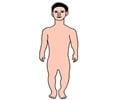Frequently Asked Questions
1. Which doctor should I consult if I suspect my child to be a case of Down syndrome?You may consult a pediatrician.
2. To what extent is Alzheimer's disease prevalent in Down syndrome?
Around 16-50% of Down syndrome individuals develop dementia associated with Alzheimer’s disease.
3. Why are Down syndrome children more prone to leukemia?
Children with Down syndrome are more prone to leukemia because the trisomic cells have increased sensitivity to radiation and other environmental triggers.
4. Is iron in food safe for children with Down syndrome?
Yes it is. Although iron is present in the plaques that form in the brain of DS people, iron taken through normal diet is safe.
5. Is Down syndrome an inherited condition?
Trisomy 21 and mosaic Down syndrome are not inherited. The third kind known as translocation can be inherited. Children born to parents with this condition are at increased risk.
6. Should adults with Down syndrome be treated the same way as children with the syndrome?
No, they should not. On the other hand, they enjoy activities and the companionship of adults. They also have similar needs and feelings that match with their typical peers.
7. Do smoking, alcohol consumption and inhaling drugs during pregnancy cause Down syndrome in the child?
No, they cannot because Down syndrome is a chromosomal problem that occurs at the time of conception. But addictions like these during pregnancy can cause other birth defects.
8. Does Down syndrome affect all people in the world alike?
Yes. The incidence and prevalence of Down syndrome do not vary depending on the race, socio-economic status and the location of the person.
9. Does the mother’s age have an impact on bearing a child with Down syndrome?
The chances of giving birth to a baby with Down syndrome increase with age but since younger women bear more children, they end up having more kids with the syndrome. In fact, 80% of children who have Down syndrome are born to women younger than 35.
10. Do people with Down syndrome look alike?
Although many affected people have similarities in their facial feature, they tend to look more like their families than each other.













